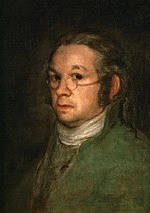How to Pronounce Francisco Goya
#50
Most Popular
Boost
Mar 30, 1746 Fuendetodos, Aragon, Spain Died on 16 Apr 1828 (aged 82)
Spanish painter and printmaker (1746-1828)
AriesFrancisco Goya, Date of Birth, Place of Birth, Family, Facts, Age, Net Worth, Biography and More in FamedBorn.com

Spanish painter and printmaker (1746-1828)
Aries